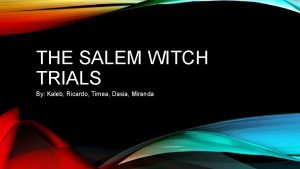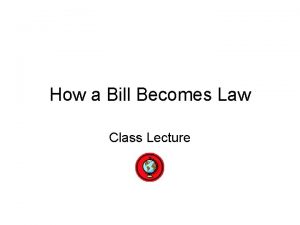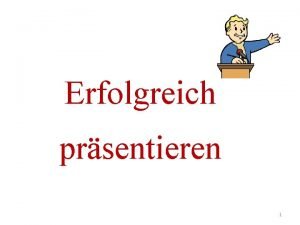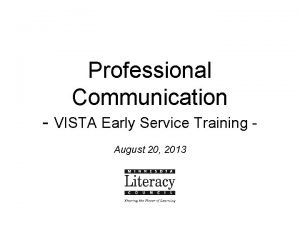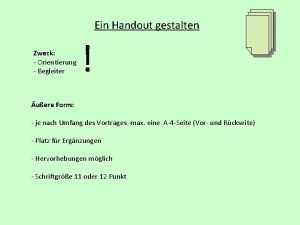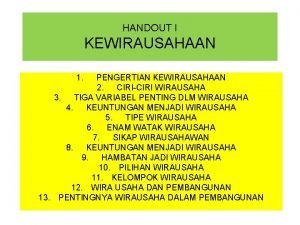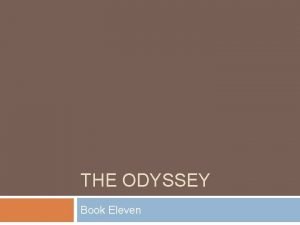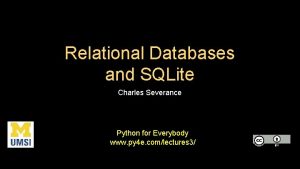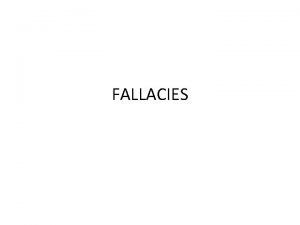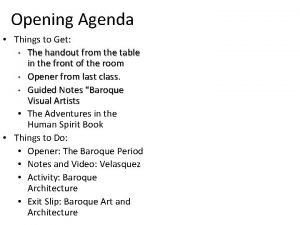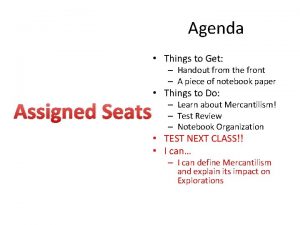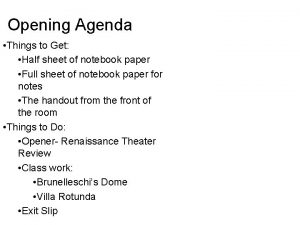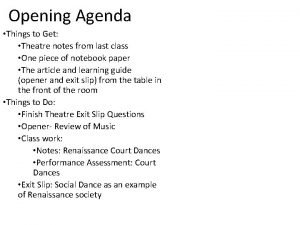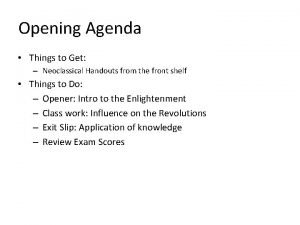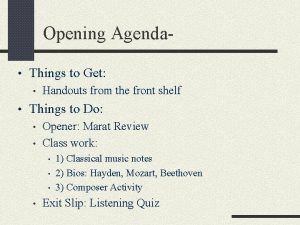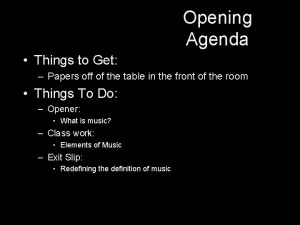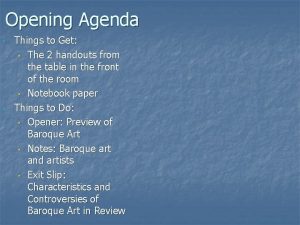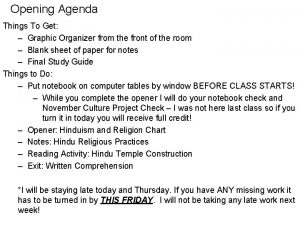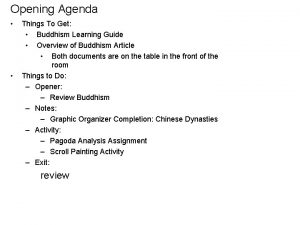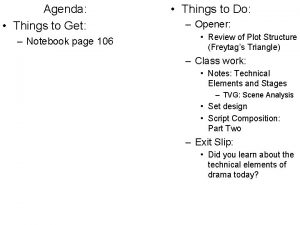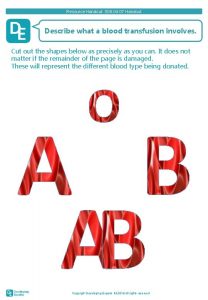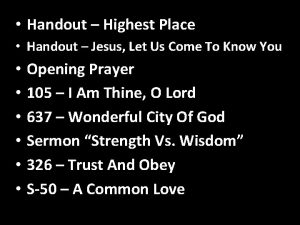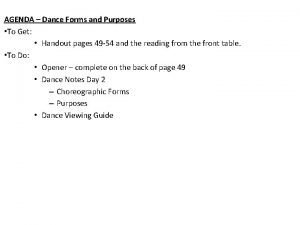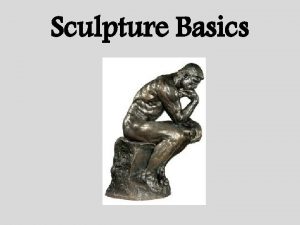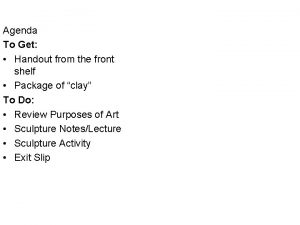Opening Agenda Things to Get Handout from the


































- Slides: 34

Opening Agenda • Things to Get: • Handout from the front table • Things to Do: • Opener- Reading • Class work: • Commedia dell’Arte notes and application • Elizabethan theater notes and application • Exit Slip

FYI • Cincinnati Art Museum Fieldtrip 4/9 Tuesday after spring break. More info to follow in mid. March. • Latin Ballroom Dance instructor will be coming the last week in February. We will be learning how to Merengue! (and maybe Rumba) • January Culture Project Due 1/31 A-Day and 1/30 B-Day

Opener- Review Complete these questions on your opener sheet 1) Identify the title and composer of the piece played. 2) Identify the title, composer, and form of the second piece played. 3) Why was Palestrina’s music different than Des Prez’s? 4) Which painter was described as being a better sculptor than painter? 5) Why was the Virgin on the Rocks so controversial that Da. Vinci had to repaint it? 6) What subject matter is Raphael famous for depicting? 7) What style of dance developed during the Renaissance? 8) Why were aspects such as a bow, the step to either side, lack of physical contact, and an emphasis on foot movements characteristics of Renaissance court dances? Use your notes to help you!

• • 1. John Farmer, Fair Phyllis 2. Palestrina, Kyrie, Mass 3. Restrained Polyphony 4. Michelangelo 5. No religious clues or information 6. Madonnas 7. Ballet 8. Show quick wit, etiquette and good breeding($!)

Renaissance Theater Commedia dell’Arte

Commedia dell’ Arte- Overview improvisational comedy Traveling actors invented dialogue for bare plot outline Used novels, gossip, and current events cast of 12 stock characters (stereotyped personalities) • 9 men/3 women – all played by men • • •

History and Background 1500 -1700’s Italy Manager led troupe/wrote scripts 2 Stock character types: upper class and servant class • Characters identified by costumes/masks • Mobile stage • •

Scenarios -plot outlines posted backstage before each performance Lazzi -memorized lines/humorous scenes -apart from main action -ignored by main characters Verisimilitude - “being true to life; ” - all characters and situations be recognizable and verifiable from real life.

Stock Characters Pulcinella hunchback chases women zanni La Ruffiana (Old Woman) mother or gossipy townswoman intrudes into the lives of the Lovers. Zanni poor servants from Bergamo, Italy move to Venice for better jobs

Arlecchino • Servant • zanni • poor peasant • Illiterate, pretends to read • Acrobat/clown • stick-slapstick (homey the clown) • patchworked clothing

Brighella • fat and slow • always the butt of a joke • simpelton • told not to do things but desires get the better of him or her

Columbina • maidservant to the lovers • lover of Arlecchino • intelligent

Dottore • local aristocrat • Doctor • snobbish • rich • adores food and good wine, fat

Capitano • Boastful but cowardly Spaniard • Brags of battles never fought and romances never experienced (who does he look like? )


Pantalone • rich and miserly merchant • father of one of the lovers • employs Arlecchino and treats him cruelly

Pedrolino • Overly kind zanni • Gets blamed for everything and he agrees that it is always his fault

Commedia dell-arte Viewing: On your viewing guide! • As you watch the following two clips, answer the questions found on your Renaissance Theater opener, viewing guide, and exit slip paper. • Note: – You will watch two videos BASED on Italian Renaissance Theater ideas. Answer the question on your viewing guide to show your understanding of Commedia dell’arte. – HC - http: //www. youtube. com/watch? v=2 g 1 e 8 d. ZM 3 MY – WL - http: //www. youtube. com/watch? v=f 6 Dj 0 MQP 7 h. Q Start at 5: 00 minutes

From Italy to England

The Elizabethan Age • England’s Renaissance – named after Queen Elizabeth 1 st – love of language and the art of theater

Developments to Theater • Went from amateur status to professional status – Effect: Companies of professional actors gave playwrights a more stable and experienced group of performers • Building of permanent theaters – Spaces were now specifically designed to present plays

Theater Hating • The church thought that “all theatre that was not religious in nature was evil” – No theaters in London • White Flag flying= play today The Globe Theater

Theater Construction Circular or octagonal Three stories Open roof Open platform with little or no scenery placed on it • Plat form stage surrounded on three sides by an audience (closer to a proscenium • • arch stage) – Tiring house: stage house; backdrop for the action – Inner Stage: roofed area that was used to suggest an inside setting (back of the platform) – Musicians’ gallery: where a small group of musicians would play music

Form of English Plays • Series of brief scenes that frequently changed location from place to place – one group of characters left the stage and another group entered, the audience knew that the scene was changing – spoken décor: when a character signals a scene change by announcing it • freer use of stage space • Iambic pentameter: words have 2 syllables to each beat and when spoken, stress is place on the second beat

Spectators • Wealthy got benches • “Groundlings”>poorer people stood and watched from the courtyard (“pit”) • All but wealthy were uneducated/illiterate • Much more interaction than today

Actors • Only men and boys • Young boys whose voices had not changed play women’s roles • Would have been considered indecent for a woman to appear on stage

William Shakespeare Widely regarded as the greatest writer in English Literature

Shakespeare • 1563 -1616 • Stratford-on-Avon, England • wrote 37 plays – comedies, tragedies, histories • about 154 sonnets • started out as an actor

Stage Celebrity • Actor for Lord Chamberlain’s Men (London theater co. ) • Also > principal playwright for them • 1599> Lord Ch. Co. built Globe Theater where most of Shakespeare’s Play’s were performed

Romeo and Juliet • Written about 1595 • Considered a tragedy • West Side Story (Movie) based on R&J

Exit Slip • While watching the following clip, answer the questions found on your Renaissance Theater Learning Guide.

Hamlet

Activity: Commedia dell’arte • Objective: – To demonstrate your understanding of the role of stock characters in an improv work • Assignment: – Groups of Three – Given an commedia dell’arte scenario to act out • Grading: All participation points can be earned if… – Actors create, maintain, and exemplify a stock character that is true to the scenario provided – Advance the storyline beyond the plot summary provided • Time Allowed: – To practice (assign roles, etc. ): 5 minutes – Performance time required: 45 secs to 1 minute

Show Time! • Each group will have one minute to perform • Groups will perform in the order lined up around the room – Once one group concludes, the next group must elect a member to read their given scenario. Scene must begin at the conclusion of the reading. Timer will begin as soon as scenario reading is complete.
 Get on get off get in get out
Get on get off get in get out Shot me out of the sky you're my kryptonite meaning
Shot me out of the sky you're my kryptonite meaning Agenda sistemica y agenda institucional
Agenda sistemica y agenda institucional Sequence in pseudocode
Sequence in pseudocode Get up get moving quiz
Get up get moving quiz Get focused get results
Get focused get results Get up get moving quiz
Get up get moving quiz Germer
Germer Get up get moving
Get up get moving Who is who
Who is who What sort of evidence was used to arrest accused witches
What sort of evidence was used to arrest accused witches Lecture handout
Lecture handout How a bill becomes a law student handout
How a bill becomes a law student handout Slidetodoc.com
Slidetodoc.com Handout 5-2 graphic organizer the brain answers
Handout 5-2 graphic organizer the brain answers How does a plant resist disease and pests journey 2050
How does a plant resist disease and pests journey 2050 Wise mind handout
Wise mind handout Ted talk compassion fatigue
Ted talk compassion fatigue The human respiratory system chapter 7 handout
The human respiratory system chapter 7 handout Pengertian orientasi
Pengertian orientasi Johari window handout
Johari window handout Wound healing nutrition handout
Wound healing nutrition handout Handout stichpunkte
Handout stichpunkte Ciri-ciri handout
Ciri-ciri handout Karakteristik handout
Karakteristik handout Ciri-ciri handout
Ciri-ciri handout Cheo constipation handout
Cheo constipation handout Book eleven handout the odyssey
Book eleven handout the odyssey Define handouts
Define handouts Py4e database handout
Py4e database handout Rolling with resistance means
Rolling with resistance means Fat tom handout
Fat tom handout Reggae referat
Reggae referat Site:slidetodoc.com
Site:slidetodoc.com Non sequitur fallacy definition
Non sequitur fallacy definition










